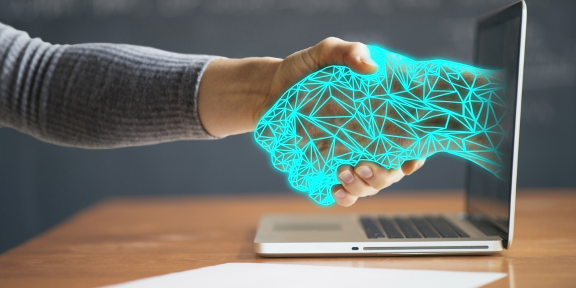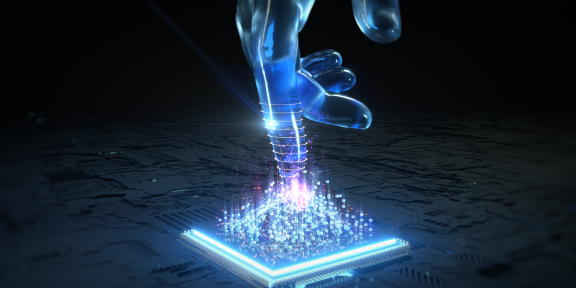The Future of Innovation: Demystifying Generative AI and its Limitless Possibilities

Artificial Intelligence (AI) has revolutionized various industries, from healthcare to finance. One of the most intriguing branches of AI is generative AI. Generative AI refers to the technology that enables machines to generate new content, such as images, music, and text, without explicit human input. It is a fascinating field that holds immense potential for innovation and creativity.
Generative AI works by leveraging deep learning algorithms, neural networks and natural language processing. These algorithms are trained on vast amounts of data to learn patterns and generate new content based on the knowledge acquired. The concept of generative AI may seem complex, but understanding its basics can help us appreciate its limitless possibilities and what is going on behind the scenes of the tools we are using.
Understanding the Basics
Generative AI is based on a foundation models of learning from data and generating new content. At the core of generative AI are Generative Adversarial Networks (GANs), which consist of two neural networks: a generator and a discriminator. The generator network generates new content, while the discriminator network evaluates and distinguishes between the generated content and real content.
The generator network starts by creating random noise and transforming it into content that resembles the training data. The discriminator network then evaluates the content and provides feedback to the generator network, enabling it to refine its output. This iterative process continues until the generator network becomes proficient at generating content that is indistinguishable from real data.
Applications of Generative AI in Various Industries
Generative AI has the potential to revolutionize countless industries. In the field of healthcare, it can be used to generate synthetic patient data, which can aid in medical research and accelerate drug discovery. In the entertainment industry, AI can create realistic virtual characters for movies and video games, reducing the need for human actors. Additionally, AI can automate the design process in architecture and fashion, generating unique and innovative designs.
Moreover, generative AI can be applied in the field of marketing and advertising. It can help businesses create personalized content for their customers, such as tailored advertisements and product recommendations. This level of personalization can significantly enhance customer engagement and drive sales. Using large language models (LLM) has opened the door for generative AI work in numerous fields. The applications of AI are vast and continue to expand as the technology advances.

The Impact of Generative AI on Creativity and Innovation
Generative AI has the potential to unlock new levels of creativity and innovation. By automating certain aspects of content creation, it frees up human creators to focus on higher-level tasks. For example, in the field of music, generative AI can compose unique melodies and harmonies, allowing musicians to explore new sonic landscapes and experiment with different genres.
Furthermore, AI can facilitate collaboration between humans and machines. Artists, writers, and designers can use generative AI as a tool to inspire and enhance their creative process. It can provide a starting point or generate alternative ideas, sparking new directions and possibilities. The integration of generative AI into the creative workflow can lead to groundbreaking innovations and the emergence of new artistic expressions.
Limitations and Challenges of Generative AI
While the generative AI model holds immense potential, it also faces several limitations and challenges. One major challenge is the issue of bias. Since AI learns from existing data, it can perpetuate and amplify biases present in the training data. For example, if the training data is predominantly male-centric, the generated content may exhibit gender bias. Addressing this challenge requires careful curation of training data and ongoing monitoring of the output.
Another limitation of AI is the lack of control over the generated content. While machines can generate impressive results, they may not always align with the desired outcome. This lack of control can hinder the adoption of generative AI in certain industries where precision and reliability are crucial. Striking a balance between creative freedom and control is a challenge that researchers and developers must address.

Ethical Considerations in Generative AI
As with any powerful technology, AI raises ethical considerations that need to be addressed. The potential for misuse and the creation of deepfakes, which are manipulated or fabricated content, is a significant concern. This can have severe consequences in various domains, including politics, journalism, and public trust. Developing safeguards and regulations to prevent the malicious use of generative AI work is essential to ensure its responsible deployment.
Another ethical consideration is the ownership and copyright of generated content. Who should be credited as the creator if a machine is the one doing image generation or a piece of art or music? These questions have legal and ethical implications that need to be carefully considered to protect the rights and interests of both human creators and consumers.
Current Trends and Advancements in Generative AI
Generative AI is a rapidly evolving field, with new advancements and trends emerging continuously. One notable trend is the integration of AI with other technologies, such as virtual reality (VR) and augmented reality (AR). This integration allows for immersive experiences and interactive content creation, opening up new possibilities in entertainment, education, and training.
Another significant advancement is the development of conditional generative models. These models enable the generation of content based on specific input conditions, such as style, mood, or context. This enhances the control and customization of generated content, making it more tailored to specific needs and preferences.

The Future of Generative AI and Its Potential Impact
The future of generative AI is promising, with its potential impact spanning across various industries and domains. As the technology continues to advance, we can expect more sophisticated and realistic generated content. This can lead to the creation of entirely virtual worlds, where humans can explore and interact in immersive environments.
In the field of medicine, generative AI can aid in the development of personalized treatments and therapies. By analyzing individual patient data, generative AI algorithms can generate treatment plans tailored to each patient’s unique needs, leading to more effective and efficient healthcare.
Moreover, generative AI can contribute to the democratization of creativity. It can empower individuals who may not have traditional artistic skills to express themselves through generated content. The accessibility and ease of use of generative AI tools can lower barriers to entry, allowing more people to participate in creative endeavors.
Industries That Can Benefit from Generative AI
Generative AI has the potential to benefit a wide range of industries. In the field of manufacturing, it can optimize production processes by generating efficient designs and reducing waste. In the financial sector, generative AI can enhance fraud detection systems by generating synthetic data to simulate fraudulent activities, enabling more accurate and proactive detection.
Additionally, generative AI can revolutionize the field of education by creating personalized learning experiences. It can generate customized educational content tailored to each student’s learning style and pace, fostering engagement and improving learning outcomes. The applications of generative AI are extensive and can transform industries by streamlining processes, enhancing creativity, and improving decision-making.

Wrap Up
Generative AI holds immense potential to transform industries, unleash creativity, and drive innovation. By understanding its basics, applications, limitations, and ethical considerations, we can navigate the evolving landscape of generative AI responsibly. As the technology continues to advance, it is essential to embrace its limitless possibilities while addressing the challenges it presents.
As we look to the future, it is crucial to foster collaboration between humans and machines and develop frameworks that ensure the responsible and ethical deployment of generative AI. By harnessing the power of generative AI, we can unlock new frontiers of innovation, creativity, and discovery, shaping a future where the possibilities are truly limitless.
FAQs
1. What on Earth is Generative AI?
Ah, the age-old question! Well, not that old, but you get the drift. Imagine a painter, tirelessly working on a canvas, creating masterpieces out of thin air. Now, swap that painter with a computer. Voilà! You’ve got Generative AI. It’s like the magic wand of the tech world, conjuring up images, sounds, and even text. But instead of fairy dust, it’s powered by algorithms and data. A lot of data.
| Term | Simple Explanation |
| Algorithm | A set of rules or steps |
| Data | Information fed to the computer |
2. How Does Generative AI Differ from Other AIs?
Well, well, well, aren’t we diving deep? So, there’s AI that does stuff, and then there’s AI that creates stuff. Think of it like this: some AIs are like librarians, fetching books (or data) when you ask. Generative AIs? They’re the authors, penning down new tales. It’s the difference between following a recipe and inventing a new dish. A dash of creativity, a sprinkle of tech, and bam! You’ve got Generative AI.
- Reactive AI: Responds based on set rules.
- Generative AI: Creates something new from learned data.
3. What’s the Big Deal with GPT and DALL·E?
Oh boy, where do I start? These two are like the rockstars of the Generative AI world. GPT is the wordsmith, spinning tales and answering questions, while DALL·E is the Picasso, painting pictures with pixels. They’re the poster children of what’s possible when you let AI dream a little dream. It’s like giving a robot a paintbrush and a typewriter, and watching in awe as art unfolds.
4. Can Generative AI Replace Human Creativity?
Hold your horses! While it’s tempting to think so, there’s a twist. Generative AI can whip up a storm, create melodies, and even write poems. But, and it’s a big but, it lacks the human touch. It’s like comparing a photograph to a memory. Both capture moments, but one has emotion, the other, pixels. So, while AI can mimic the process, the soul? That’s all human.
5. How Safe is Generative AI?
Safety first, right? Generative AI, with all its bells and whistles, is a double-edged sword. On one hand, it can create. On the other, it can deceive. Fake news, deepfakes, you name it. It’s a Pandora’s box, and once opened, there’s no going back.
| Pros | Cons |
| Innovation | Misinformation |
| Efficiency | Ethical concerns |
6. What’s the Learning Curve for Generative AI?
Climbing the Generative AI mountain isn’t a walk in the park. But it’s not scaling Everest either. With the right tools and a pinch of patience, anyone can dip their toes. It’s like learning to ride a bike. Wobbly at first, but once you get the hang of it, it’s a breeze.
7. How Can I Get Started with Generative AI?
Jumping on the bandwagon? Great choice! There’s a smorgasbord of resources out there. Online courses, tutorials, forums – the world’s your oyster. Just remember, every expert was once a beginner. So, roll up those sleeves and dive in!
- Start with: Basic programming or prompting. ChatGPT is a great place to get your toes wet.
- Dive into: Machine learning concepts
- Master: Generative models
8. What are the Limitations of Generative AI?
Ah, the chink in the armor! Generative AI isn’t perfect. Sometimes, it’s like a toddler with a crayon – unpredictable. It can’t think or feel, and often, it’s as good as the data it’s fed. Garbage in, garbage out, as they say.
9. How Will Generative AI Shape the Future?
Peering into the crystal ball, the future with Generative AI looks, well, futuristic. Smart cities, personalized entertainment, virtual realities – the sky’s the limit. But, like every coin, there’s a flip side. It’s a brave new world, but with great power comes great responsibility.
10. Are There Ethical Concerns Surrounding Generative AI?
Bingo! You’ve hit the nail on the head. The ethical maze of Generative AI is as complex as its algorithms. Who’s accountable? What’s real? What’s fake? It’s a minefield, and navigating it requires a moral compass. As we stand on the cusp of this revolution, it’s imperative to tread with caution.
| Question | Summary |
| What is Generative AI? | A type of AI that creates content like images, sounds, and text using algorithms and data. |
| How does it differ from other AIs? | Unlike reactive AI that responds based on set rules, generative AI creates something new from learned data. |
| What’s the deal with GPT and DALL·E? | They are prominent examples of generative AI, with GPT focused on text and DALL·E on images. |
| Can it replace human creativity? | While it can mimic processes, it lacks the human touch and emotion. |
| How safe is it? | It has potential for innovation but also risks like misinformation and ethical concerns. |
| What’s the learning curve? | Requires understanding of programming and machine learning, but is accessible with dedication. |
| How to get started? | Begin with basic programming, then delve into machine learning and generative models. |
| What are its limitations? | It’s unpredictable and is only as good as the data it’s trained on. |
| How will it shape the future? | It promises advancements like smart cities but also poses ethical challenges. |
| Are there ethical concerns? | Yes, issues of accountability, reality vs. fakery, and the need for a moral compass are paramount. |
